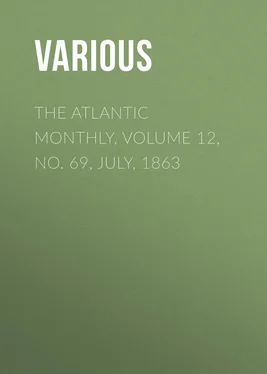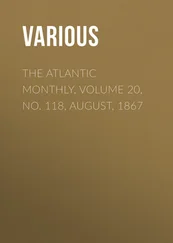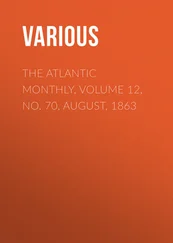Various - The Atlantic Monthly, Volume 12, No. 69, July, 1863
Здесь есть возможность читать онлайн «Various - The Atlantic Monthly, Volume 12, No. 69, July, 1863» — ознакомительный отрывок электронной книги совершенно бесплатно, а после прочтения отрывка купить полную версию. В некоторых случаях можно слушать аудио, скачать через торрент в формате fb2 и присутствует краткое содержание. Жанр: foreign_antique, periodic, foreign_edu, на английском языке. Описание произведения, (предисловие) а так же отзывы посетителей доступны на портале библиотеки ЛибКат.
- Название:The Atlantic Monthly, Volume 12, No. 69, July, 1863
- Автор:
- Жанр:
- Год:неизвестен
- ISBN:нет данных
- Рейтинг книги:4 / 5. Голосов: 1
-
Избранное:Добавить в избранное
- Отзывы:
-
Ваша оценка:
- 80
- 1
- 2
- 3
- 4
- 5
The Atlantic Monthly, Volume 12, No. 69, July, 1863: краткое содержание, описание и аннотация
Предлагаем к чтению аннотацию, описание, краткое содержание или предисловие (зависит от того, что написал сам автор книги «The Atlantic Monthly, Volume 12, No. 69, July, 1863»). Если вы не нашли необходимую информацию о книге — напишите в комментариях, мы постараемся отыскать её.
The Atlantic Monthly, Volume 12, No. 69, July, 1863 — читать онлайн ознакомительный отрывок
Ниже представлен текст книги, разбитый по страницам. Система сохранения места последней прочитанной страницы, позволяет с удобством читать онлайн бесплатно книгу «The Atlantic Monthly, Volume 12, No. 69, July, 1863», без необходимости каждый раз заново искать на чём Вы остановились. Поставьте закладку, и сможете в любой момент перейти на страницу, на которой закончили чтение.
Интервал:
Закладка:
Let him who wishes to know what war is look at this series of illustrations. These wrecks of manhood thrown together in careless heaps or ranged in ghastly rows for burial were alive but yesterday. How dear to their little circles far away most of them!—how little cared for here by the tired party whose office it is to consign them to the earth! An officer may here and there be recognized; but for the rest—if enemies, they will be counted, and that is all. "80 Rebels are buried in this hole" was one of the epitaphs we read and recorded. Many people would not look through this series. Many, having seen it and dreamed of its horrors, would lock it up in some secret drawer, that it might not thrill or revolt those whose soul sickens at such sights. It was so nearly like visiting the battlefield to look over these views, that all the emotions excited by the actual sight of the stained and sordid scene, strewed with rags and wrecks, came back to us, and we buried them in the recesses of our cabinet as we would have buried the mutilated remains of the dead they too vividly represented. Yet war and battles should have truth for their delineator. It is well enough for some Baron Gros or Horace Vernet to please an imperial master with fanciful portraits of what they are supposed to be. The honest sunshine
"Is Nature's sternest painter, yet the best";
and that gives us, even without the crimson coloring which flows over the recent picture, some conception of what a repulsive, brutal, sickening, hideous thing it is, this dashing together of two frantic mobs to which we give the name of armies. The end to be attained justifies the means, we are willing to believe; but the sight of these pictures is a commentary on civilization such as a savage might well triumph to show its missionaries. Yet through such martyrdom must come our redemption. War Is the surgery of crime. Bad as it is in itself, it always implies that something worse has gone before. Where is the American, worthy of his privileges, who does not now recognize the fact, if never until now, that the disease of our nation was organic, not functional, calling for the knife, and not for washes and anodynes?
It is a relief to soar away from the contemplation of these sad scenes and fly in the balloon which carried Messrs. King and Black in their aërial photographic excursion. Our townsman, Dr. John Jeffries, as is well recollected, was one of the first to tempt the perilous heights of the atmosphere, and the first who ever performed a journey through the air of any considerable extent. We believe this attempt of our younger townsmen to be the earliest in which the aëronaut has sought to work the two miracles at once, of rising against the force of gravity, and picturing the face of the earth beneath him without brush or pencil.
One of their photographs is lying before us. Boston, as the eagle and the wild goose see it, is a very different object from the same place as the solid citizen looks up at its eaves and chimneys. The Old South and Trinity Church are two landmarks not to be mistaken. Washington Street slants across the picture as a narrow cleft. Milk Street winds as if the cowpath which gave it a name had been followed by the builders of its commercial palaces. Windows, chimneys, and skylights attract the eye in the central parts of the view, exquisitely defined, bewildering in numbers. Towards the circumference it grows darker, becoming clouded and confused, and at one end a black expanse of waveless water is whitened by the nebulous outline of flitting sails. As a first attempt it is on the whole a remarkable success; but its greatest interest is in showing what we may hope to see accomplished in the same direction.
While the aëronaut is looking at our planet from the vault of heaven where he hangs suspended, and seizing the image of the scene beneath him as he flies, the astronomer is causing the heavenly bodies to print their images on the sensitive sheet he spreads under the rays concentrated by his telescope. We have formerly taken occasion to speak of the wonderful stereoscopic figures of the moon taken by Mr. De la Rue in England, by Mr. Rutherford and by Mr. Whipple in this country. To these most successful experiments must be added that of Dr. Henry Draper, who has constructed a reflecting telescope, with the largest silver reflector in the world, except that of the Imperial Observatory at Paris, for the special purpose of celestial photography. The reflectors made by Dr. Draper "will show Debilissima quadruple, and easily bring out the companion of Sirius or the sixth star in the trapezium of Orion." In taking photographs from these mirrors, a movement of the sensitive plate of only one-hundredth of an inch will render the image perceptibly less sharp. It was this accuracy of convergence of the light which led Dr. Draper to prefer the mirror to the achromatic lens. He has taken almost all the daily phases of the moon, from the sixth to the twenty-seventh day, using mostly some of Mr. Anthony's quick collodion, and has repeatedly obtained the full moon by means of it in one-third of a second .
In the last "Annual of Scientific Discovery" are interesting notices of photographs of the sun, showing the spots on his disk, of Jupiter with his belts, and Saturn with his ring.
While the astronomer has been reducing the heavenly bodies to the dimensions of his stereoscopic slide, the anatomist has been lifting the invisible by the aid of his microscope into palpable dimensions, to remain permanently recorded in the handwriting of the sun himself. Eighteen years ago, M. Donné published in Paris a series of plates executed after figures obtained by the process of Daguerre. These, which we have long employed in teaching, give some pretty good views of various organic elements, but do not attempt to reproduce any of the tissues. Professor O.N. Rood, of Troy, has sent us some most interesting photographs, showing the markings of infusoria enormously magnified and perfectly defined. In a stereograph sent us by the same gentleman the epithelium scales from mucous membrane are shown floating or half-submerged in fluid,—a very curious effect, requiring the double image to produce it. Of all the microphotographs we have seen, those made by Dr. John Dean, of Boston, from his own sections of the spinal cord, are the most remarkable for the light they throw on the minute structure of the body. The sections made by Dr. Dean are in themselves very beautiful specimens, and have formed the basis of a communication to the American Academy of Arts and Sciences, in which many new observations have been added to our knowledge of this most complicated structure. But figures drawn from images seen in the field of the microscope have too often been known to borrow a good deal from the imagination of the beholder. Some objects are so complex that they defy the most cunning hand to render them with all their features. When the enlarged image is suffered to delineate itself, as in Dr. Dean's views of the medulla oblongata , there is no room to question the exactness of the portraiture, and the distant student is able to form his own opinion as well as the original observer. These later achievements of Dr. Dean have excited much attention here and in Europe, and point to a new epoch of anatomical and physiological delineation.
The reversed method of microscopic photography is that which gives portraits and documents in little. The best specimen of this kind we have obtained is another of those miracles which recall the wonders of Arabian fiction. On a slip of glass, three inches long by one broad, is a circle of thinner glass, as large as a ten-cent piece. In the centre of this is a speck, as if a fly had stepped there without scraping his foot before setting it down. On putting this under a microscope magnifying fifty diameters there come into view the Declaration of Independence in full, in a clear, bold type, every name signed in fac-simile; the arms of all the States, easily made out, and well finished; with good portraits of all the Presidents, down to a recent date. Any person familiar with the faces of the Presidents would recognize any one of these portraits in a moment.
Читать дальшеИнтервал:
Закладка:
Похожие книги на «The Atlantic Monthly, Volume 12, No. 69, July, 1863»
Представляем Вашему вниманию похожие книги на «The Atlantic Monthly, Volume 12, No. 69, July, 1863» списком для выбора. Мы отобрали схожую по названию и смыслу литературу в надежде предоставить читателям больше вариантов отыскать новые, интересные, ещё непрочитанные произведения.
Обсуждение, отзывы о книге «The Atlantic Monthly, Volume 12, No. 69, July, 1863» и просто собственные мнения читателей. Оставьте ваши комментарии, напишите, что Вы думаете о произведении, его смысле или главных героях. Укажите что конкретно понравилось, а что нет, и почему Вы так считаете.












